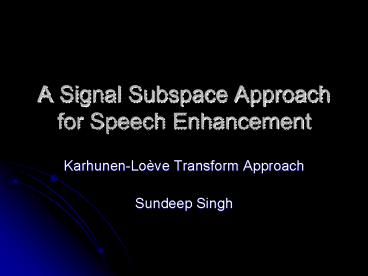A Signal Subspace Approach for Speech Enhancement - PowerPoint PPT Presentation
1 / 13
Title:
A Signal Subspace Approach for Speech Enhancement
Description:
?z is a diagonal matrix of the eigenvalues of the noisy signal ... On a 1.3 GHz processor, with 99% CPU utilization: 5ms frame - 20s running time ... – PowerPoint PPT presentation
Number of Views:92
Avg rating:3.0/5.0
Title: A Signal Subspace Approach for Speech Enhancement
1
A Signal Subspace Approach for Speech Enhancement
- Karhunen-Loève Transform Approach
- Sundeep Singh
2
Signal Spaces
- Signal occupies an N-dimensional space (for a
vector of length N) - For speech signal, the speech occupies only a
subspace of the entire N-dimensional space - White noise occupies the entire N-dimensional
space - For noisy signal zyw, find the subspace that
contains the speech and project z onto this
subspace for the estimate of the clean signal, y
3
Subspace Linear Estimator
4
Karhunen-Loève Expansion
- Decompose a general second-order random process
into an orthonormal expansion, whose coefficients
are uncorrelated random variables - There exists at least one set of orthonormal
functions with the property that the coefficients
in its expansion are uncorrelated random
variables - Different from the Fourier series expansion,
because the coefficients are uncorrelated, or
statistically orthogonal - X(t) ?Xnfn(t) (in the mean square sense)
5
K-L Transform
- KLT is the theoretically optimal transform for
transform coding - Implemented in this algorithm by using an
empirical estimate based on eigendecomposition of
the (Toeplitz) covariance matrix - Decomposes the vector space of the noisy signal
into a signal(noise) subspace and a noise
subspace - Linear estimation is performed by modifying the
KLT components which lie in the signal subspace
by a gain function, determined by an estimator - Enhanced signal is obtained from the inverse KLT
of the altered components
6
K-L Transform (cont.)
- Find covariance matrix of a frame of noisy
speech, Rz - Find covariance matrix of the noise, Rw this is
a diagonal matrix with each element on the
diagonal equal to the variance of the noise, s² - s² is estimated from the first few frames of the
speech signal, since there is all noise and no
speech
7
K-L Transform (cont.)
- Perform eigendecomposition on Rz to find the
eigenvectors and eigenvalues of the noisy signal,
RzU?zU - ?z is a diagonal matrix of the eigenvalues of the
noisy signal - U is a matrix of the corresponding eigenvectors
- ?z(k)s² in the noise subspace
- ?z(k)?y(k)s² in the signal subspace
- So for the eigenvalues which are greater than s²,
we can assume those lie in the signal subspace.
8
Implementation
- For each of the eigenvalues, ?z(k), of the noisy
signal, compare the values to the variance of the
noise, s² - If the eigenvalue is greater than the noise
variance, assume it lies in the signal subspace
along with its corresponding eigenvector - Otherwise, assume it lies in the noise subspace,
and null it and its corresponding eigenvector - To estimate the eigenvalues, ?y(k), of the clean
signal, take the noisy eigenvalues which lie in
the signal subspace and subtract the noise
variance
9
Implementation (cont.)
- The gain function and inverse transform can be
implemented via a filter, H - Let yHz be a linear estimator of the clean
signal y, where H is a NN matrix - It can be shown that the optimal H to estimate
the clean signal is HU1GµU1 - U1 is the matrix of eigenvectors that correspond
to the eigenvalues in the signal subspace - Gµ is a diagonal matrix, with the gain values as
elements on the diagonal - gµ(m) ?y(m) / (?y(m) µs²)
- µ is the LaGrange multiplier, which can be
estimated in several ways, or chosen to be an
arbitrary value
10
Algorithm Complexity
- Each frame of the noisy signal has a unique
filter, H, which cleans it up - Very computationally expensive to implement,
because a new filter has to be computed for each
frame - As frame size increases, the covariance matrices
get larger, and running time of the algorithm
increases - On a 1.3 GHz processor, with 99 CPU utilization
- 5ms frame - 20s running time
- 10ms frame - 48s running time
- 20ms frame - 147s running time
11
Audio Demos (µ10)
- Noisy signal, 0 dB SNR
- Enhanced signal
- Noisy signal, 5 dB SNR
- Enhanced signal
- Noisy signal, 10 dB SNR
- Enhanced signal
12
Effect of µ on output of algorithm
- As µ increases, the residual noise decreases
while signal distortion increases - The effect of changes in µ becomes apparent in
highly noisy signals - Noisy signal, -5 db SNR
- Enhanced signal, µ0
- Enhanced signal, µ10
- Enhanced signal, µ100
13
The End































